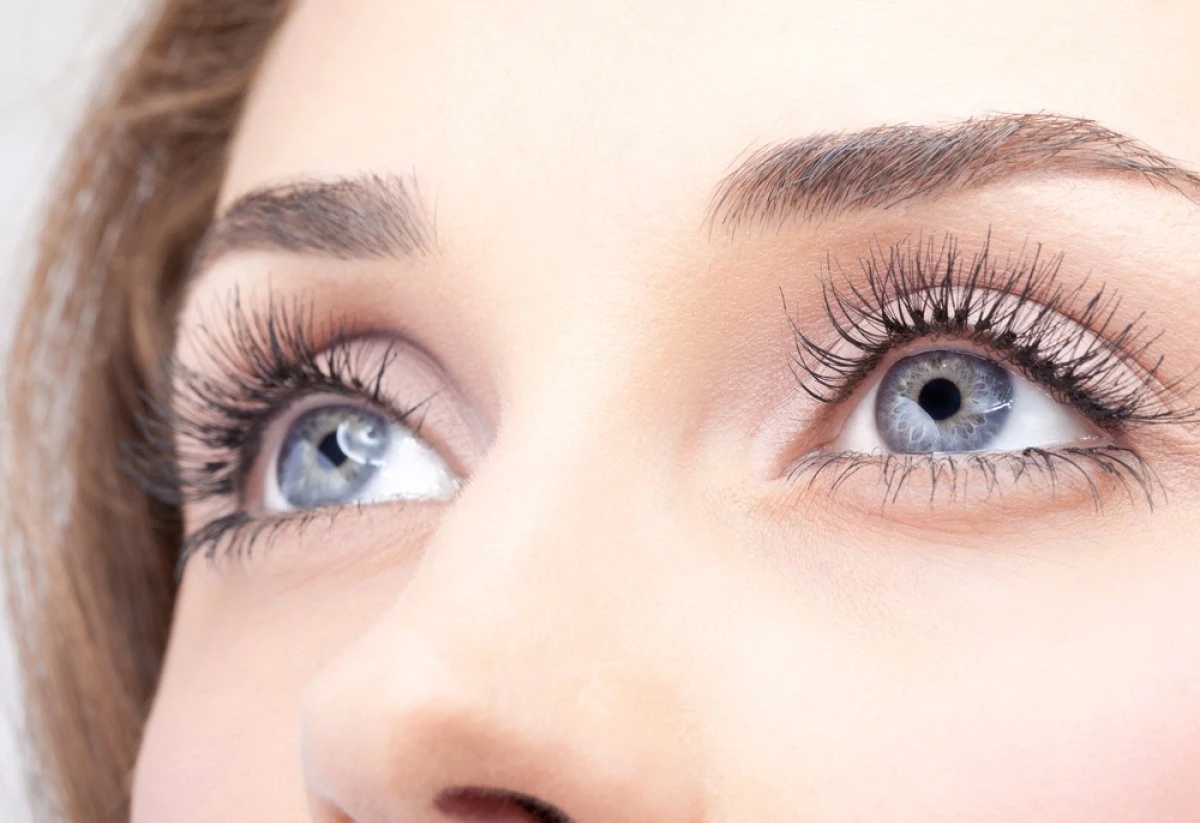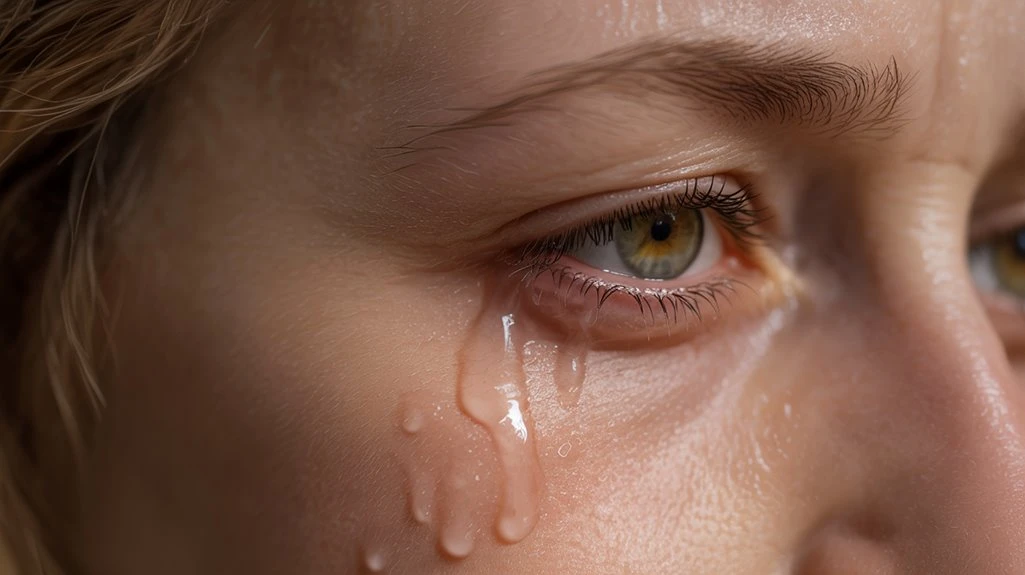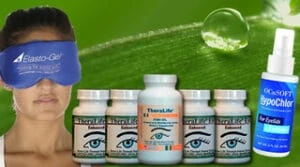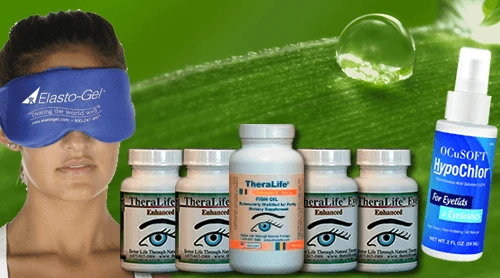When eyes feel dry yet appear watery, it’s often due to surface irritation causing reflex tearing from the lacrimal glands. These reflex tears are rich in aqueous fluid but lack the necessary mucin and lipid components to stabilize the tear film. Consequently, the eyes may appear moist but still suffer from dryness and irritation, as the tears fail to adequately coat or protect the surface.
Theralife’s products uniquely benefit customers by addressing this imbalance through their innovative oral dry eye treatment care, which is not available from any other company. Theralife’s approach focuses on restoring tear stability and reducing inflammation, thereby providing comprehensive relief for dry eyes. Their products are designed to work from within, offering a holistic solution to eye health challenges.
Best Oral Dry Eye Treatment That Works With Contact Lenses.
Add To Cart
Key Takeaways
- Dry eyes can trigger a reflex response, leading to excess watery tear production as the eyes try to compensate for dryness.
- Reflex tears lack essential lipid and mucin layers, making them less effective at lubricating and protecting the ocular surface.
- Environmental factors like wind, smoke, or prolonged screen use can destabilize the tear film and worsen both dryness and watery symptoms.
- An unstable tear film causes irritation, prompting the lacrimal glands to produce more watery tears that don’t relieve dryness.
- Persistent watery eyes despite dryness may signal an imbalance in tear composition, indicating underlying tear film or ocular surface issues.
Understanding the Tear Film and Its Role
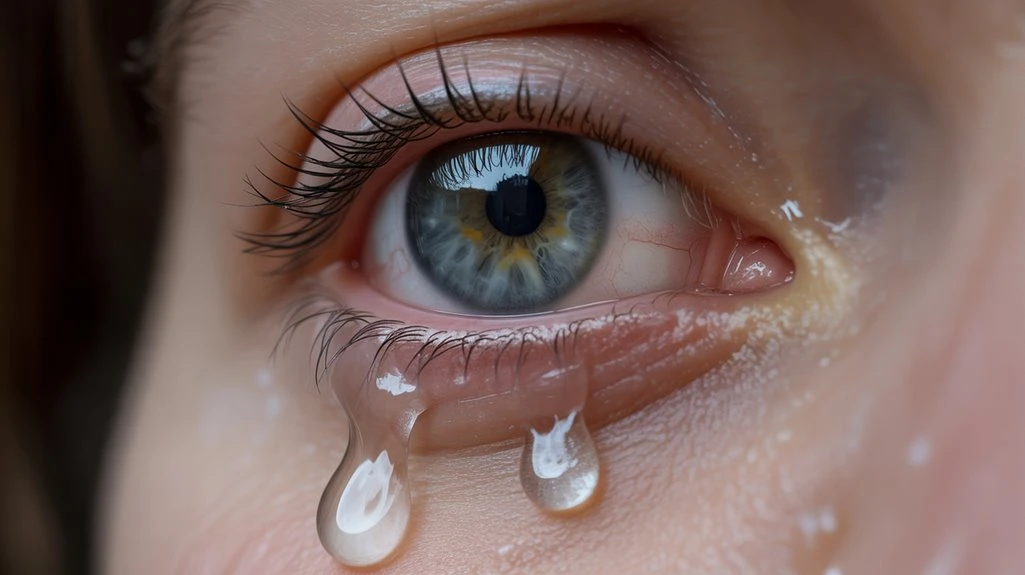
The tear film consists of three distinct layers—lipid, aqueous, and mucin—that work together to maintain ocular surface health. You rely on ideal tear composition to guarantee proper eye lubrication and barrier function. The outermost lipid layer, derived from meibomian glands, minimizes tear evaporation and stabilizes the ocular surface. The central aqueous layer, secreted by the lacrimal glands, delivers nutrients, antimicrobial proteins, and hydration. Closest to the corneal epithelium, the mucin layer, produced by conjunctival goblet cells, promotes adherence of the tear film to the ocular surface, reducing friction and enhancing uniform tear distribution. Any imbalance or deficiency in these layers disrupts eye lubrication, leading to surface desiccation, epithelial compromise, and symptoms consistent with dry eye disease despite apparent tearing. Symptoms of dry eye, such as burning and itching, can also be exacerbated by environmental factors, leading to increased discomfort.
The Body’s Reflex Response to Dryness
When ocular surface sensors detect increased dryness or irritation, neural pathways trigger a compensatory reflex that stimulates the lacrimal glands to produce excess aqueous tears. You may perceive this as watery eyes, even though the underlying issue is dry eye symptoms.
This mechanism, known as reflex tearing, doesn’t address the deficiency in the lipid or mucin layers of the tear film but instead results in a transient overproduction of low-quality tears. These reflex tears lack the stability and composition necessary to effectively lubricate the ocular surface. Consequently, you experience persistent discomfort despite the presence of apparent tearing.
- Reflex tears are primarily aqueous, lacking essential mucin and lipid components.
- Neural feedback loops regulate tear secretion in response to irritation.
- Excessive tearing paradoxically exacerbates dry eye symptoms.
- Tear film instability perpetuates the cycle of ocular surface irritation.
- Chronic dry eyes can lead to severe complications like blepharitis, which further exacerbate discomfort and inflammation.
Common Triggers That Make Dry Eyes Water
Although dry eye primarily results from insufficient tear film quality, various environmental and behavioral factors can provoke excessive tearing episodes.
Exposure to wind, smoke, and dry air disrupts the ocular surface, triggering a reflexive increase in tear production. Changes in humidity and temperature act as environmental factors that exacerbate evaporative loss, compelling your eyes to overcompensate with watery secretions.
Digital device use induces reduced blink rate, intensifying tear evaporation and subsequent reflex tearing. Allergies symptoms, such as itching and irritation, can also stimulate your lacrimal glands, leading to excess watery discharge.
Additionally, contact lens wear, exposure to airborne irritants, or frequent rubbing of the eyes may further destabilize the tear film, prompting paradoxical tearing despite underlying dryness. Managing meibomian gland dysfunction is crucial, as it can significantly impact tear film stability and exacerbate dry eye symptoms.
Recognizing these triggers is essential for effective management.
How to Tell If Your Tears Are Healthy
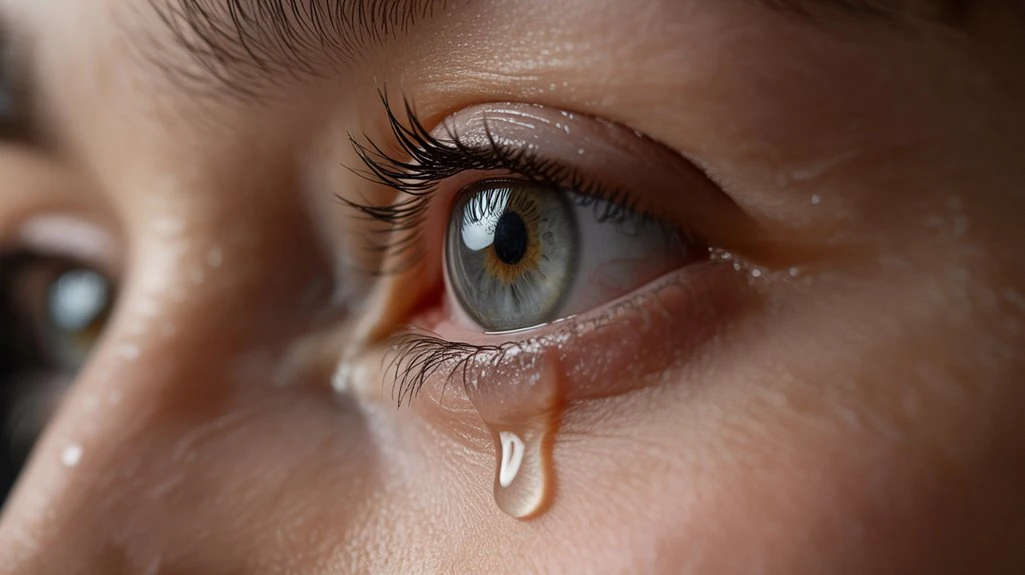
Recognizing what healthy tears look and feel like can help you distinguish normal eye moisture from symptoms of dry eye disease.
Healthy tears rely on ideal tear composition—a balanced mix of water (aqueous), oil (lipid), and mucus (mucin) layers—to maintain eye health and clear vision.
You’ll notice if your tear film is functioning well by monitoring these clinical markers:
- Clarity: Healthy tears don’t blur your vision or leave a filmy residue.
- Comfort: You experience minimal irritation, stinging, or burning sensations.
- Stability: Tears coat your eyes evenly, preventing dryness between blinks.
- Absence of Excess: Your eyes aren’t persistently watery or producing excessive discharge.
Imbalances in tear composition—whether from insufficient oil, water, or mucus—often signal underlying eye health concerns, including dry eye disease. Neuropathic ocular pain is a recognized feature of dry eye, with symptoms potentially aligning more closely with non-ocular conditions.
Effective Ways to Manage Watery Dry Eyes
Curiously, managing watery dry eyes requires more than simply wiping away excess tears—it involves addressing the underlying instability of your tear film. You should prioritize replenishing the deficient tear film with preservative-free artificial tears, which can stabilize the ocular surface and reduce reflex tearing. Select formulations tailored to your specific deficiency, such as lipid-based drops for evaporative dry eye. Additionally, lifestyle changes are essential: minimize screen time, increase blink frequency, guarantee adequate hydration, and avoid direct exposure to air conditioning or wind. Environmental modifications like using humidifiers can support tear film integrity. TheraLife® Eye Autoimmune Formula targets chronic dry eyes, dry mouth, joint pain, and fatigue, helping to restore natural cell functions and regulate the immune system. If symptoms persist, consult an eye care professional for advanced interventions, such as punctal plugs or topical anti-inflammatory agents, to target the root dysfunction rather than just symptomatic tearing.
Best Oral Dry Eye Treatment That Works With Contact Lenses.
Add To Cart
Frequently Asked Questions
Can Certain Medications Cause Both Dry and Watery Eyes?
Yes, certain medications can cause both dry and watery eyes as medication side effects.
You’ll find that antihistamines, antidepressants, and beta-blockers can decrease tear production, leading to dryness. The ocular surface may then compensate by producing reflex tearing, resulting in watery eyes.
If you experience these symptoms, you should discuss your medication regimen with your healthcare provider. Your clinician may recommend specific eye drops to manage the adverse effects and improve ocular comfort.
Are Watery Dry Eyes More Common in Certain Climates?
Imagine your tears evaporate like water on sunbaked pavement—this metaphor illustrates how climate impact, especially in low humidity levels, can make watery dry eyes more common.
Clinical studies confirm that arid environments increase tear evaporation, triggering reflex tearing as your eyes try to compensate.
Do Contact Lenses Worsen Watery Dry Eyes?
Contact lenses can exacerbate watery dry eyes, particularly if you use certain contact lens types that restrict oxygen permeability or absorb eye moisture.
Soft lenses, especially hydrogel variants, often dehydrate the ocular surface, intensifying tear film instability and reflex tearing.
Silicone hydrogel lenses provide better oxygenation, but may still reduce eye moisture if worn for prolonged periods.
Clinical evidence suggests that optimizing contact lens types and wear schedules mitigates worsening of symptoms in susceptible individuals.
Can Diet or Nutrition Impact Watery Dry Eyes?
Diet and nutrition greatly impact watery dry eyes.
You should guarantee ideal hydration levels, as dehydration exacerbates tear film instability.
Evidence indicates dietary supplements, such as omega-3 fatty acids, improve meibomian gland function and reduce evaporative dry eye symptoms.
Deficiencies in vitamins A, C, and E impair ocular surface health, increasing tear film irregularities.
Clinical studies support incorporating targeted dietary modifications and proper supplementation to enhance tear quality and alleviate watery dry eye manifestations.
Is Watery Dryness Linked to Underlying Health Conditions?
It’s no coincidence that you might notice watery dryness linked to underlying health conditions.
Clinical evidence shows autoimmune disorders, such as Sjögren’s syndrome, often disrupt normal tear production, leading to paradoxical tearing.
Hormonal changes, especially during menopause or thyroid dysfunction, can alter tear film stability.
If you’re experiencing persistent symptoms, consider a thorough evaluation, as these systemic factors may contribute to your ocular surface instability and require targeted medical management.
Best Oral Dry Eye Treatment That Works With Contact Lenses.
Add To Cart
Conclusion
Imagine a sprinkler system that reacts to dryness by flooding the area with excessive water. Similarly, in the case of dry eyes, your body might produce an overabundance of tears in an attempt to remedy the dryness. However, this overproduction often signals a compromised tear film rather than healthy eye lubrication.
TheraLife understands these challenges and offers a unique solution as the only company providing oral treatment care for eye conditions. Their products are designed to address the root causes of dry eye and related issues, promoting effective tear production and restoring balance to the ocular surface. With TheraLife’s evidence-based management, you can break the cycle of irritation and excess tearing, achieving relief and long-term eye health.
TheraLife’s comprehensive approach is particularly beneficial in treating conditions like blepharitis, where they offer guidance on eye hygiene and appropriate use of makeup, as well as dietary recommendations for conditions such as Sjogren’s syndrome. Their products include natural anti-inflammatory solutions and remedies for uveitis, chalazion, and more, ensuring that customers have access to a wide range of treatment options.
By choosing TheraLife, customers gain access to a reliable, holistic method of managing eye health that goes beyond temporary relief, targeting the underlying issues to improve overall eye function and comfort.

